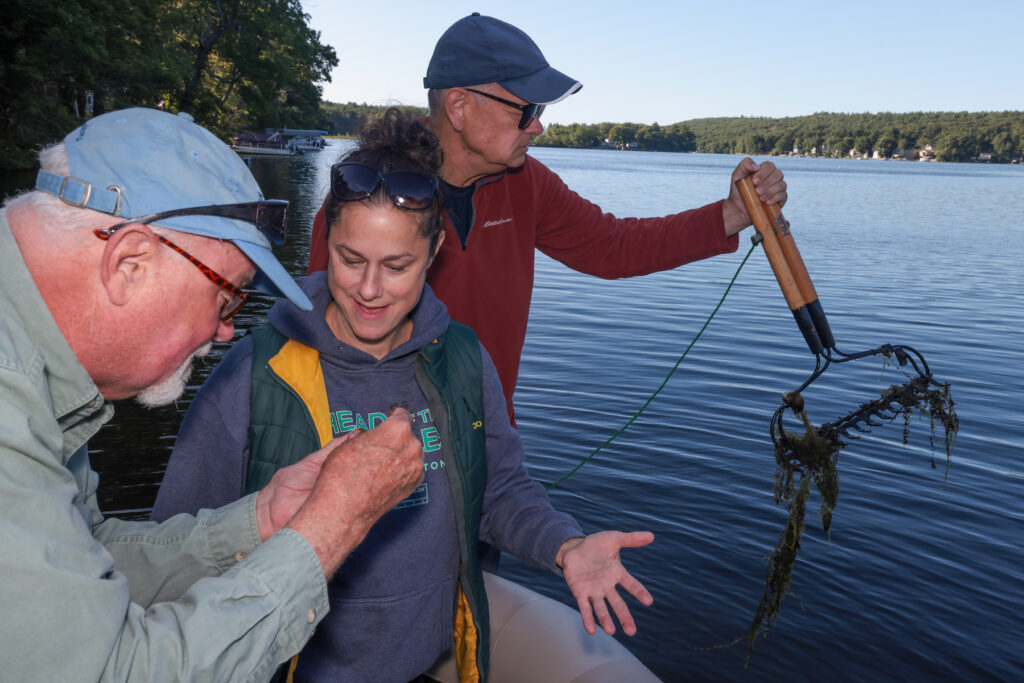
Volunteer Bill Baldiga (right) pulls up some weeds while limnologist Dave Mitchell (left) shows a sample to Lake Maspenock Preservation Association president Sabine St. Pierre.
The Lake Maspenock Weed Management and Control Citizens Input Group completed a survey of the lake on Aug. 22, which revealed a significant decrease in weeds.
After much public debate, the weed treatment was performed in June. It was approved by both the Conservation Commission and the Department of Public Works.
Sabine St. Pierre, the president of the Lake Maspenock Preservation Association (LMPA), participated in the survey, along with limnologist Dave Mitchell and Joe Baldiga, the Citizens Input Group (CIG) chair. What they found remarkable was not only the decline in the number of weeds but also a sharp increase in the number of people who enjoyed the lake this summer.
“Most areas that we looked at had trace or sparse amounts of weeds,” St. Pierre said in a post-survey interview. “I spotted some fanwort, bladderwort and tape grass.”
Added St. Pierre: “We’re proud to see this come to fruition after all the hard work over the past 10 years.”
Use of lake expands as weeds decline
Feedback the LMPA has received has been ”very, very positive,” St. Pierre said, noting that newer residents have begun exploring the lake. “I feel like we’ve had more swimmers, kayakers and paddleboarders than ever this season.”
Added Baldiga: “There was a lot more activity on Sandy Beach and in the north basin this summer due to the great weather.”
When asked about the impact on the wildlife at Lake Maspenock, St. Pierre said she has observed little, if any, change. She has seen swans, seagulls and eagles throughout the past several weeks.
“We pulled up some mussels from the bottom of the lake like we did in the past survey; they were living,” she added.
“There has been no diminishing of any fish,” said Baldiga. “There are as many ducks and other waterfowl present as there has been in previous years.”
Critics of herbicide speak out
The use of herbicides in Lake Maspenock has been controversial for the past decade. It was proposed in 2014 but voted down by a two-thirds majority at the 2015 Town Meeting because of environmental concerns.
Carol Esler, who has lived on the lake for four decades, has been one of the staunchest opponents of the herbicide application. She called it a “poisoning of the lake” and wrote a letter to the editor published on Aug. 13.
“What they did broke my heart, said Esler, a member of the Sustainable Green Committee (SGC). “They are committing ecocide and biocide.”
The town instead should instead use “integrated pest management” and use mechanical harvesting. Personal responsibility is another factor.
“If weeds are in your boat propellers, stop, bend over and pick them up,” said Esler. “Weeds are an annoyance, not a crisis.”
In mid-June, when the treatment was applied, Esler said many waterfowl species, including swans, geese, eagles, heron and ducks, left the lake. Now they are slowly returning.
Donald Sutherland, another SGC member, sent a letter to the editor published on March 28 opposing the use of herbicides.
“The use of hundreds of gallons of herbicides in Lake Maspenock is a short-sighted, wanton application of toxic chemicals,” he stated in an Aug. 27 email to the Independent.
Added Sutherland: “Decades of extensive investigative research by media, environmental organizations and peer-reviewed science bodies have revealed the powerful chemical multinational industries manufacturing pesticides are controlling the government safety review and registration of toxic chemical pesticides, and misrepresenting their risk and harm.”
“Almost every adjoining town did the same thing with herbicides without any pushback,” said Health Director Shaun McAuliffe.
New weed species detected
Department of Public Works Director Kerry Reed said a new species of weed was found in the part of the lake near the picnic tables. St. Pierre noted that this weed, the curly-leaf pondweed, is present at the hangout area for jet ski users who have caused disturbances during this summer. It may have been brought in by non-residents who fail to clean their equipment properly, she surmised.
“There was a new weed that was there, so we added it to the treatment plan,” said Reed. The treatment provided “a baseline to measure against.”
“The other area that we were using as a baseline was north of Twin Island, which is kind of marshy anyway,” Reed added. “This will be a better comparison.”
‘Nobody was excited about the use of herbicides’
St. Pierre said the pattern of weed overgrowth was what spurred the decision to use herbicides as a last resort. In June, before the treatment, a survey showed weed density typically seen in August, when there are “big rakes full of weeds.”
“There are still weeds,” St. Pierre stressed. “Some people might have the mindset that we were out to eradicate all weeds in the lake. But as we know, for an ecosystem, you still need native vegetation. People can rest assured that there’s still good places for the fish and all the wildlife in there.”
“The one thing I wanted to stress was that this was a one-time treatment,” added Reed. “It’s not a foreseen conclusion that we’re going to keep doing this.”
Added St. Pierre: “Nobody was excited about the use of herbicides.”
The DPW will continue to do the annual drawdown of the lake, which is scheduled for later this year. An extended drawdown may be performed next year because it usually is done every three years. Baldiga noted that there hasn’t been a “hard freeze” of the lake since 2006, which typically kills off weeds naturally.
‘Snail die-off’ resembles 2019 event
Esler said a casualty of the herbicide application has been the snail population. She claimed that the lake “was covered in thousands of smelly, dead snails” less than a month after the treatment.
Town officials countered that summer heatwaves and rising water temperatures, not the herbicide, caused the “snail die-off.” McAuliffe said the same thing happened in 2019.
“We’ve had more successive days of 90-degree weather, which constitutes a heat wave, than in years past,” explained Reed. “The water temperature was significantly higher than it’s been in the past.”Some fish were dying in other areas of town due to the high water temperatures.”
Stressed McAuliffe: “The limnologist and all those involved in the study of the lake agree on the reason for the snail die-off.”
McAuliffe explained ultraviolet radiation absorption caused the darker dirt at the north basin and death of snails and some fish.
“During the heatwaves, the water was 85 degrees,” he said, noting there has been regular water testing. “The higher water temperature leads to less dissolvable oxygen. Snails and fish are sensitive to this.”
Added Baldiga: “This coincidence is perfect for the naysayers.”
Esler questioned where the water temperature was taken and for how long.
Risk management plan in works
The LMPA has been working with the DPW on a risk management plan to control weed overgrowth. The LMPA also is continuing its resident education campaign about fertilizer application and proper lawn maintenance.
“We hope to go in front of the Conservation Commission and the Select Board with the report that SOLitude Weed Management is compiling,” said Baldiga.
“I realize this is an emotional issue for a lot of people,” he added. “I know they have the right intentions and want to keep the lake healthy.”














0 Comments